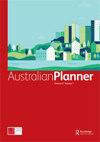The role of business agglomerations in stimulating static and social activities in multicultural streets
IF 1.2
Q2 Social Sciences
引用次数: 0
Abstract
ABSTRACT Urban designers and city planners are increasingly interested in how streets can support social activities. Street-based social activities are influenced by relationships between the street’s physical characteristics, the business activities that take place there and how these two factors are managed over time. As New Zealand’s population becomes more diverse, a key challenge is to design and manage public spaces so that people from different socio-cultural backgrounds can enjoy spending time there. The ethnic retail phenomenon is considered one of the most recognisable symbols of multiculturalism. In many cases, the identity of an ethnic neighbourhood has developed around a specific mix of retailing activities. Despite this, very little work has been done to identify the characteristics of shops and businesses along streets that can help stimulate social intercourse. This paper explores how commercial business agglomerations can support efforts to make streets more culturally diverse. Through observations of activity along streets and interviews with people from three ethnically diverse communities in New Zealand, it was revealed that the extent to which streets become the public domain of different ethnic groups is dependent on the retail activities on offer. We conclude with reflections about the importance of municipal intervention and management for multicultural planning practice in streets.商业聚集在多元文化街道上刺激静态和社会活动的作用
摘要城市设计师和城市规划者对街道如何支持社会活动越来越感兴趣。基于街道的社交活动受到街道的物理特征、在那里发生的商业活动以及这两个因素如何随着时间的推移而管理之间的关系的影响。随着新西兰人口的多样化,一个关键的挑战是设计和管理公共空间,使来自不同社会文化背景的人能够享受在那里度过的时光。民族零售现象被认为是多元文化最明显的象征之一。在许多情况下,一个民族社区的身份是围绕着零售活动的特定组合而发展起来的。尽管如此,在识别有助于刺激社交的街道上商店和企业的特征方面,几乎没有做什么工作。本文探讨了商业商业聚集如何支持街道文化多样性的努力。通过观察街道上的活动,并采访来自新西兰三个不同种族社区的人,发现街道在多大程度上成为不同种族群体的公共领域取决于所提供的零售活动。最后,我们反思了城市干预和管理对街道多元文化规划实践的重要性。
本文章由计算机程序翻译,如有差异,请以英文原文为准。
求助全文
约1分钟内获得全文
求助全文

 求助内容:
求助内容: 应助结果提醒方式:
应助结果提醒方式:


